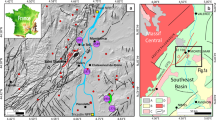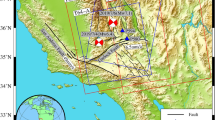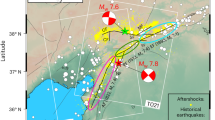Abstract
Earthquakes radiate from slip on discrete faults, but also commonly involve distributed deformation within a broader fault zone, especially near the surface. Variations in rock strain during an earthquake are caused by heterogeneity in the elastic stress before the earthquake, by variable material properties and geometry of the fault zones, and by dynamic processes during the rupture1,2. Stress changes due to the earthquake slip, both dynamic and static, have long been thought to cause dilatancy in the fault zone that recovers after the earthquake3,4,5. Decreases in the velocity of seismic waves passing through the fault zone due to coseismic dilatancy have been observed6 followed by postseismic seismic velocity increases during healing5,7,8. Dilatancy and its recovery have not previously been observed geodetically. Here we use interferometric analysis of synthetic aperture radar images to measure postseismic surface deformation after the 2003 Bam, Iran, earthquake and show reversal of coseismic dilatancy in the shallow fault zone that causes subsidence of the surface. This compaction of the fault zone is directly above the patch of greatest coseismic slip at depth. The dilatancy and compaction probably reflects distributed shear and damage to the material during the earthquake that heals afterwards. Coseismic and postseismic deformation spread through a fault zone volume may resolve the paradox of shallow slip deficits for some strike-slip fault ruptures9.
This is a preview of subscription content, access via your institution
Access options
Subscribe to this journal
Receive 51 print issues and online access
$199.00 per year
only $3.90 per issue
Buy this article
- Purchase on Springer Link
- Instant access to full article PDF
Prices may be subject to local taxes which are calculated during checkout




Similar content being viewed by others
References
Mai, P. M. & Beroza, G. C. A spatial random field model to characterize complexity in earthquake slip. J. Geophys. Res. 107 2308 10.1029/2001JB000588 (2002)
Ben-Zion, Y. & Sammis, C. G. Characterization of fault zones. Pure Appl. Geophys. 160, 677–715 (2003)
Nur, A. Effects of stress on velocity anisotropy in rocks with cracks. J. Geophys. Res. 76, 2022–2034 (1971)
Scholz, C. H. Post-earthquake dilatancy recovery. Geology 2, 551–554 (1974)
Vidale, J. E. & Li, Y.-G. Damage to the shallow Landers fault from the nearby Hector Mine earthquake. Nature 421, 524–526 (2003)
Li, Y.-G., Chen, P., Cochran, E. S., Vidale, J. E. & Burdette, T. Seismic evidence for rock damage and healing on the San Andreas Fault associated with the 2004 M 6.0 Parkfield earthquake. Bull. Seismol. Soc. Am. 96, S349–S363 (2006)
Schaff, D. P. & Beroza, G. C. Coseismic and postseismic velocity changes measured by repeating earthquakes. J. Geophys. Res. 109 B10302 10.1029/2004JB003011 (2004)
Peng, Z. G. & Ben-Zion, Y. Temporal changes of shallow seismic velocity around the Karadere-Düzce branch of the North Anatolian Fault and strong ground motion. Pure Appl. Geophys. 163, 567–600 (2006)
Fialko, Y., Sandwell, D., Simons, M. & Rosen, P. A. Three-dimensional deformation caused by the Bam, Iran, earthquake and the origin of shallow slip deficit. Nature 435, 295–299 (2005)
Bürgmann, R. & Dresen, G. Rheology of the lower crust and upper mantle: Evidence from rock mechanics, geodesy and field observations. Annu. Rev. Earth Planet. Sci. 36, 531–567 (2008)
Jónsson, S., Segall, P., Pedersen, R. & Bjornsson, G. Post-earthquake ground movements correlated to pore-pressure transients. Nature 424, 179–183 (2003)
Peltzer, G., Rosen, P., Rogez, F. & Hudnut, K. Postseismic rebound in fault step-overs caused by pore fluid-flow. Science 273, 1202–1204 (1996)
Johanson, I. A., Fielding, E. J., Rolandone, F. & Burgmann, R. Coseismic and postseismic slip of the 2004 Parkfield earthquake from geodetic data. Bull. Seismol. Soc. Am. 96, S269–S282 (2006)
Langbein, J., Murray, J. R. & Snyder, H. A. Coseismic and initial postseismic deformation from the 2004 Parkfield, California, earthquake, observed by global positioning system, electronic distance meter, creepmeters, and borehole strainmeters. Bull. Seismol. Soc. Am. 96, S304–S320 (2006)
Hsu, Y. J. et al. Frictional afterslip following the 2005 Nias-Simeulue earthquake, Sumatra. Science 312, 1921–1926 (2006)
Talebian, M. et al. The 2003 Bam (Iran) earthquake: Rupture of a blind fault. Geophys. Res. Lett. 31 L11611 10.1029/2004GL020058 (2004)
Funning, G. J., Parsons, B. E., Wright, T. J., Jackson, J. A. & Fielding, E. J. Surface displacements and source parameters of the 2003 Bam (Iran) earthquake from Envisat advanced synthetic aperture radar imagery. J. Geophys. Res. 110 B09406 10.1029/2004JB003338 (2005)
Fielding, E. J. et al. Surface ruptures and building damage of the 2003 Bam, Iran, earthquake mapped by satellite synthetic aperture radar interferometric correlation. J. Geophys. Res. 110 B03302 10.1029/2004JB003299 (2005)
Jackson, J. A. et al. Seismotectonic, rupture-process, and earthquake-hazard aspects of the 26 December 2003 Bam, Iran, earthquake. Geophys. J. Int. 166, 1270–1292 (2006)
Motagh, M. et al. Combination of precise leveling and InSAR data to constrain source parameters of the Mw = 6.5, 26 December 2003 Bam earthquake. Pure Appl. Geophys. 163, 1–18 (2006)
Peyret, M. et al. The source motion of 2003 Bam (Iran) earthquake constrained by satellite and ground-based geodetic data. Geophys. J. Int. 169, 849–865 (2007)
Bürgmann, R., Rosen, P. A. & Fielding, E. J. Synthetic aperture radar interferometry to measure Earth's surface topography and its deformation. Annu. Rev. Earth Planet. Sci. 28, 169–209 (2000)
Sadeghi, H., Aghda, S. M. F., Suzuki, S. & Nakamura, T. 3-D velocity structure of the 2003 Bam earthquake area (SE Iran): Existence of a low-Poisson's ratio layer and its relation to heavy damage. Tectonophysics 417, 269–283 (2006)
Peltzer, G., Rosen, P., Rogez, F. & Hudnut, K. Poroelastic rebound along the Landers 1992 earthquake surface rupture. J. Geophys. Res. 103, 30131–30145 (1998)
Hamiel, Y., Lyakhovsky, V. & Agnon, A. Coupled evolution of damage and porosity in poroelastic media: Theory and applications to deformation of porous rocks. Geophys. J. Int. 156, 701–713 (2004)
Rosen, P. A., Hensley, S., Peltzer, G. & Simons, M. Updated repeat orbit interferometry package released. Eos 85, 47 (2004)
Chen, C. W. & Zebker, H. A. Network approaches to two-dimensional phase unwrapping: Intractability and two new algorithms. J. Opt. Soc. Am. A 17, 401–414 (2000)
Berardino, P., Fornaro, G., Lanari, R. & Sansosti, E. A new algorithm for surface deformation monitoring based on small baseline differential SAR interferograms. IEEE Trans. Geosci. Rem. Sens. 40, 2375–2383 (2002)
Lohman, R. B. & Simons, M. Some thoughts on the use of InSAR data to constrain models of surface deformation: Noise structure and data downsampling. Geochem. Geophys. Geosyst. 6 Q01007 10.1029/2004GC000841 (2005)
Thomas, A. L. Poly3D: A Three-Dimensional, Polygonal Element, Displacement Discontinuity Boundary Element Computer Program with Applications to Fractures, Faults, and Cavities in the Earth's Crust. M.Sc. Thesis, Stanford Univ. (1993)
Acknowledgements
Envisat data are copyright 2004–07 European Space Agency and were provided under AOE project 668. We thank R. Lohman for the use of data resampling programs and discussions. We thank J. Jackson, M. Talebian, D. McKenzie, J.-P. Avouac, Z. Liu, Z.H. Li, E. Cochran, F. Horowitz, G. Peltzer, Y. Ben-Zion and E. Hearn for discussions. Part of this research was performed at the Jet Propulsion Laboratory, California Institute of Technology, under contract with the National Aeronautics and Space Administration.
Author Contributions E.J.F. performed the data analysis, interpretation and modelling. P.R.L. wrote the time series analysis and modelling framework programs, and contributed to interpretation. R.B. and G.J.F. contributed to modelling and interpretation. E.J.F. and R.B. wrote the manuscript with contributions from all authors.
Author information
Authors and Affiliations
Corresponding author
Supplementary information
Supplementary Information
This file contains Supplementary Notes, Supplementary Figures S1-S9 with Legends, Supplementary Tables S1-S5 and Supplementary References (PDF 3119 kb)
Rights and permissions
About this article
Cite this article
Fielding, E., Lundgren, P., Bürgmann, R. et al. Shallow fault-zone dilatancy recovery after the 2003 Bam earthquake in Iran. Nature 458, 64–68 (2009). https://doi.org/10.1038/nature07817
Received:
Accepted:
Issue Date:
DOI: https://doi.org/10.1038/nature07817
This article is cited by
-
How much the Iranian government spent on disasters in the last 100 years? A critical policy analysis
Cost Effectiveness and Resource Allocation (2020)
-
Localized fault-zone dilatancy and surface inelasticity of the 2019 Ridgecrest earthquakes
Nature Geoscience (2020)
-
Dominant Afterslip of the 2010 Mw 6.9 Yushu, Tibetan Plateau Earthquake as Derived from GPS Observations: Implication for Seismic Hazard Assessment
Pure and Applied Geophysics (2020)
-
Volume unbalance on the 2016 Amatrice - Norcia (Central Italy) seismic sequence and insights on normal fault earthquake mechanism
Scientific Reports (2019)
-
A model to explain joint patterns found in ignimbrite deposits
Bulletin of Volcanology (2018)
Comments
By submitting a comment you agree to abide by our Terms and Community Guidelines. If you find something abusive or that does not comply with our terms or guidelines please flag it as inappropriate.



